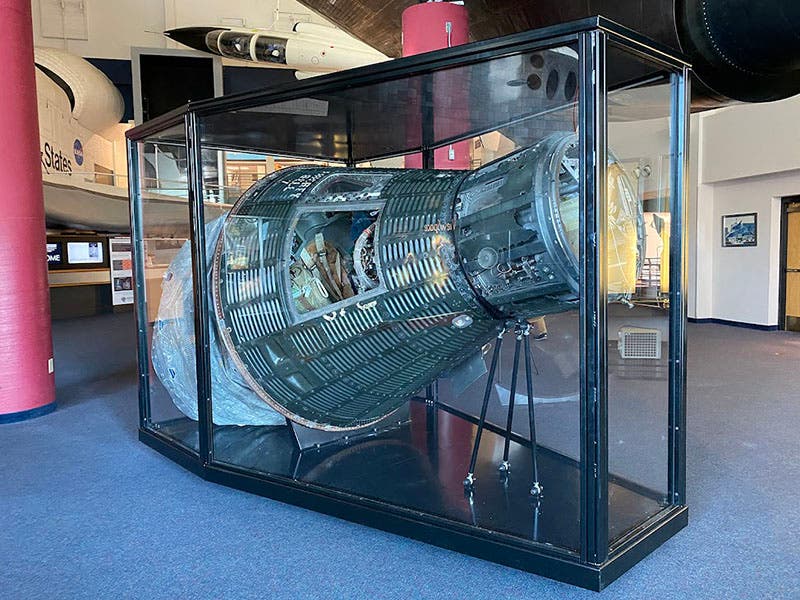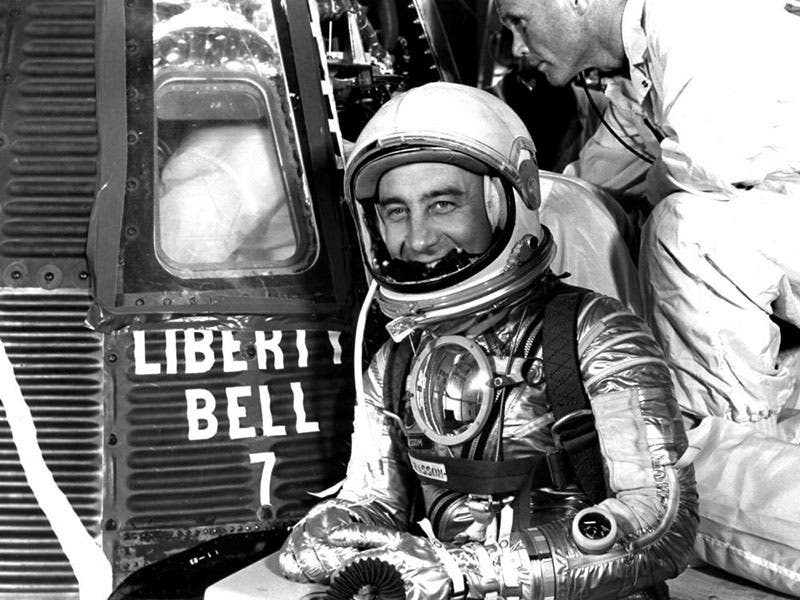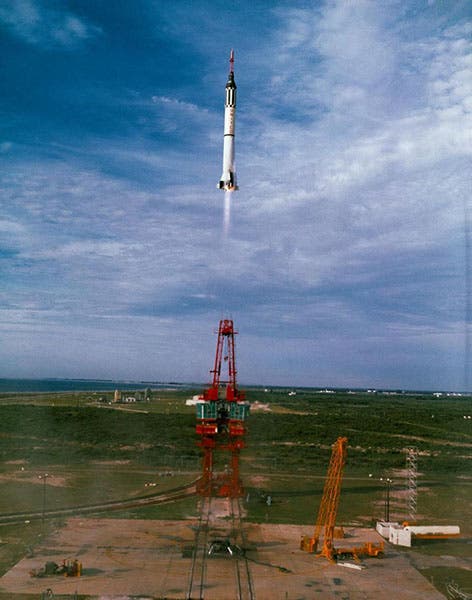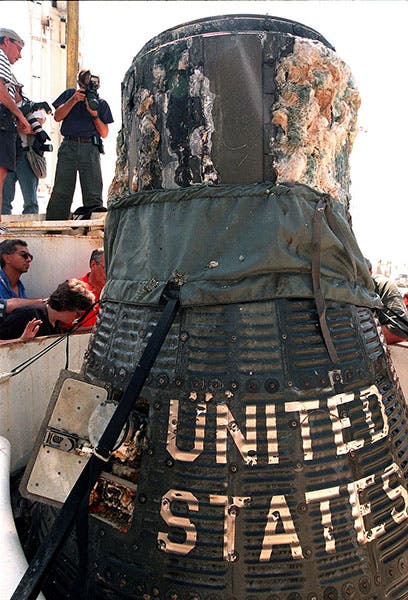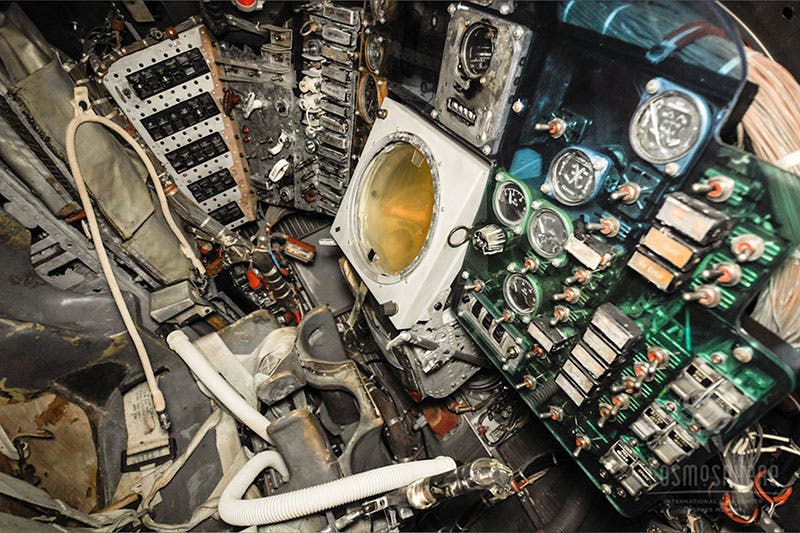Scientist of the Day - Liberty Bell 7
Liberty Bell 7, a space capsule, was launched atop a Mercury-Redstone 4 rocket, on July 21, 1961. As the second manned flight of Project Mercury, Liberty Bell 7 carried astronaut Gus Grissom on board (we sometimes read, “with Gus Grissom at the controls,” but the fact is, there was nothing for the Mercury “pilots” to pilot – they were, in Chuck Yeager’s famous words, just “spam-in-a-can”). This was just 10 weeks after Alan Shepard had become the first American in space.
Grissom's flight, like Shepard's, was sub-orbital, and lasted just 15 minutes, before the Liberty Bell 7 splashed down in the Atlantic, whereupon the uneventful flight suddenly became eventful. While Grissom lay there in his bobbing capsule, waiting for the helicopters to arrive, the hatch suddenly blew (which means 70 explosive bolts fired all at once) and opened the capsule to the waves. Water poured in, and Grissom managed to escape, but despite the efforts of the recovery helicopters to keep the capsule afloat, it grew too heavy and had to be cut loose, at which point it sank to the bottom of the ocean some 15,000 feet below.
Grissom swore up and down that he hadn't touched the hatch-release controls, but the implication was always there that he had screwed up somehow and triggered the hatch bolts. In the film, The Right Stuff (1983), there is a scene where Grissom's wife tries to come to terms with the fact that, because of Gus’s mishap, she would not be invited to the White House and get to meet Jackie Kennedy. Fred Ward played Gus Grissom, in a terrific performance. It's too bad the film was twice as long as it needed to be, but even so, it joins a small list of must-see astronaut movies, the other being Apollo 13.
Grissom must have been innocent in the eyes of NASA, because he flew on Gemini 3 in 1965 and was then selected as an Apollo astronaut, before tragically dying in the Apollo 1 fire in 1967. The Liberty Bell 7 capsule sat there on the ocean floor for almost four decades, where it was a tempting target for underwater treasure hunters, but no one could find it, until the Discovery Channel in the late 1990s put up the funds for an intensive search. The capsule was finally located in 1999, and it was successfully hoisted to the surface on July 20, 1999, just one day shy of the date it went down, 38 years before. Here we see it on the deck of the recovery ship (fourth image). It was in surprisingly good shape, since it was made mostly of aluminum, which doesn’t easily corrode, and was sullied only by a cabin full of undersea gook. The Spaceworks division of the Cosmosphere in Hutchinson, Kansas, undertook the task of restoring the capsule, which meant reducing it to 25,000 individual parts that had to be cleaned of salt and then reinstalled. Once reassembled, Liberty Bell 7 went on an extended tour of the country and then was returned to Hutchinson, where you can view it on display today (first image, but see caveat below).
Also on display at the Cosmosphere are other tidbits and artifacts recovered from the Liberty Bell 7, which include a Jim Bowie-like survival knife, a Boy Scout match container, and about 40 Mercury-head dimes that had been smuggled into various nooks and crannies, some by Grissom, others apparently by the launch crew. There were even two dollar bills that had been signed by Grissom and sealed into heat-shrink tubing and then tucked into wiring harnesses. These would have been great souvenirs, had the capsule returned as planned.
I have visited the Cosmosphere, and if you haven't been there, you should really make the effort to venture into the wilds of south-central Kansas. Not only can you see Liberty Bell 7 and Gus Grissom's coin collection, but the Apollo 13 capsule is there too, as well as a V-1 flying bomb and a V-2 rocket, and even a complete SR-71 Blackbird hanging from the ceiling. They also have the world’s only left-over Sputnik, the backup to the one that the Russians launched in 1957, and a slew of other Soviet hardware. It is the finest air-and-space museum outside of our nation’s capital, and it has items (like the Sputnik) that even the National Air and Space Museum lacks. Plus, you can stay in an Amish bed-and-breakfast if you like, eat breakfast at a diner that directs “cars to the left and carriages to the right,” and breakfast on fried corn-meal mush and local-farm sausage. Try that in Washington, D.C.
Be aware that Liberty Bell 7 goes out on tour regularly (sixth image), so it is best to check with the Museum before venturing out onto the prairie. The Cosmosphere’s webpage for Liberty Bell 7 has a phone number you can call to ascertain its current whereabouts. The extensive webpage also has a great collection of photos, and quite a few useful links, including one to the Discovery Channel program about the recovery of the capsule from the ocean floor.
William B. Ashworth, Jr., Consultant for the History of Science, Linda Hall Library and Associate Professor emeritus, Department of History, University of Missouri-Kansas City. Comments or corrections are welcome; please direct to ashworthw@umkc.edu.


